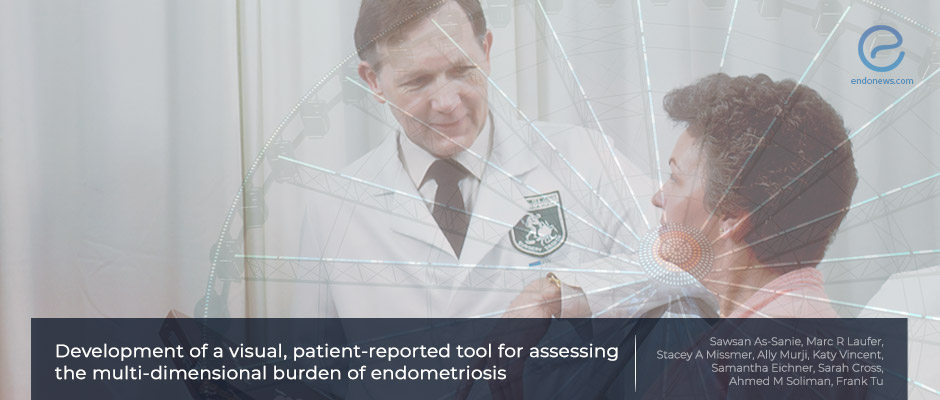A new assessment tool for the multi-dimensional burden of endometriosis
Sep 24, 2021
A patient-reported visual assessment tool called the EndoWheel may be helpful in understanding the patient’s burden
Key Points
Highlight:
- This newly developed, patient-reported, visual assessment tool called “the Endowheel” promises to be helpful by providing better patient-physician communication.
- With a better understanding of the burden of the disease symptoms that the patients have, it will be a lot easier to assess their well-being from many aspects.
Importance:
- Endometriosis patients have to carry a big burden with the chronic symptoms that come with the disease such as pelvic pain and frequent bleeding.
- The symptoms may be dismissed by healthcare providers and creates many problems in their daily life.
- Even though there are tools that aim to be used in this regard, most of them are long and not patient-centered, therefore a short but comprehensive tool is needed.
Key results:
- The Endowheel was developed by a Delphi consensus process and is made of 10 symptom domains.
- The participants are asked to document their symptoms by giving a number to each domain from zero to 10.
- 92% of the participants agreed that the tool was helpful and could be used to close the gap between the patients and the physicians.
What’s done here?
- This article evaluates a qualitatively designed, visual assessment tool intended to be short and useful in order to better understand the burden of endometriosis symptoms on patients.
- After the assessment of the questions, a consensus was achieved with the help of many healthcare professionals and patients, followed by semi-structured qualitative interviews from 13 patients.
Strength and Limitations
- The tool is not yet validated in large clinical samples and has not been correlated with the current tools that assess the same domains.
- The tool was only designed for English-speaking adult women from Western countries.
- Studies are needed to evaluate the change in the disease burden over time.
- The tool has advantages over the other tools because of its visual nature, the short time to complete it, and the focus on multi-faceted impacts of the symptoms.
Lay Summary
Endometriosis is a disease that has multiple effects on patients’ lives in various ways. The quality of life, the status of the patient’s relationships, the continuity and productivity in the patient’s education and work environment, and psychological, emotional, and even financial condition of the patient all hang on by a thread. One of the most important things that impact the patient’s well-being is patient-physician communication. Most patients complain about not being understood well by their healthcare provider in terms of pain description and normalization of the symptoms.
Understanding the disease burden in chronic diseases like endometriosis may help facilitate the overall evaluation of the patient and provide better treatment. With this purpose, researchers from different centers in the USA have developed a visual patient-reported assessment tool called the EndoWheel and published an article in a recent issue of the journal Current Medical Research and Opinion where they described a Delphi consensus process in the development of this tool.
After the evaluation of the current assessment tools on endometriosis, the domains and items were refined for the new tool using an iterative Delphi consensus process which included many professionals who work with endometriosis patients, patient advocates, and patients. The selected domains were evaluated in terms of relevance and importance by 25 patients divided into four separate focus groups. After the consensus, the tool was once more assessed by 13 women with endometriosis. Finally, a tool with 10 symptom domains was created which included pelvic pain, vaginal bleeding, bowel and bladder symptoms, energy and fatigue, sexual well-being, fertility, social and recreational activities, work/school/other daily tasks, self-image and perception, and emotional well-being. Researchers stated that these symptoms may be seen in many other diseases that coexist with endometriosis therefore this tool was not designed to be diagnostic. The participants are asked to give a number to each of the symptoms from zero to 10, the higher the numbers the further the place on the wheel which represents a greater burden of endometriosis symptoms. As a result, 92% of the participants agreed that the tool was useful and could help them communicate better with their healthcare providers.
The features of the tool were discussed broadly by the researchers. It was told that it was designed to be patient-reported and short but comprehensive that covers the multi-faceted impact of endometriosis symptoms. It is believed that this tool will be helpful in closing the gap between the patients and the physicians in the treatment course of the disease.
Research Source: https://pubmed.ncbi.nlm.nih.gov/34008451/
endometriosis assessment tool quality of life disease burden symptoms communication endowheel

